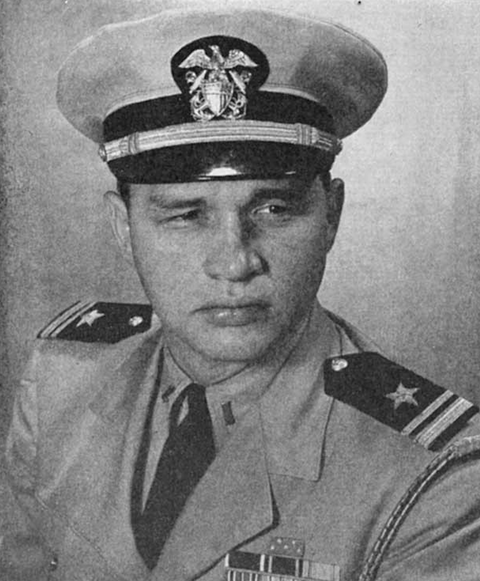
He Survived a Kamikaze Attack and Saved His Men. His Name Says It All: McCool.
It was the largest Allied amphibious landing in the Pacific theater and marked the final island battle of the Pacific.
On April 1, 1945, approximately 60,000 U.S. Marines and soldiers of the U.S. Tenth Army waded ashore from landing craft onto the beaches of Okinawa.
Dubbed the “Typhoon of Steel” due to its ferocity, Army and Marine divisions in the Battle of Okinawa sought to wrest the island from Japanese control to sever the last southwest supply line to mainland Japan, while establishing the island as a base for American medium bombers.
Amid the chaos and constant onslaught of Japanese aerial attacks, was 23-year- old Lt. Richard Miles McCool, Jr., commander of USS LCS-122.
Stationed at Radar Picket 15, just north of Okinawa, McCool, Landing Craft Support and other destroyers were assigned to alert U.S. forces on the island of approaching enemy aircraft.
While on picket duty on June 10, the Oklahoma native got word that the destroyer USS William D. Porter — yes, the same “Willie D” that almost accidentally killed President Franklin D. Roosevelt — had been struck by a kamikaze.
The destroyer actually had initially evaded the Japanese “Val” dive bomber, but the Willie D’s string of bad luck continued to know no bounds. The Val had splashed harmlessly nearby — but it somehow ended up beneath the Willie D and promptly exploded.
According to the National WWII Museum, “the ship leapt out of the water and fell back; her power out, steam lines burst, and fires breaking out. Although the ship’s crew fought valiantly after three hours, the commanding officer ordered the ship abandoned. As the order came down, just under 300 crew had to evacuate. Performing her duty as a ‘pallbearer,’ LCS-122, with McCool in command, worked to rescue the ship’s crew. Incredibly, there were no fatalities.”
The following day, however, McCool and his crew were not as lucky.
As he recalled in an interview with the Congressional Medal of Honor Society, the destroyers were sitting in a diamond formation, acting as part of a screen some three to four miles away. That meant that in order to get to the destroyers, the Japanese had to pass right by McCool’s LCS.
The first kamikaze came at McCool low — so low, in fact, that he “was afraid that the people in the 40 millimeter gun mount might have been hit by the wheels.”
His crew managed to down the first, with the Japanese plane crashing harmlessly off the port bow.
The second kamikaze however, followed too quickly.
“I did get the guns on it, but not enough to do any good, so it hit eight to 10 feet below where I was standing … I don’t really remember much of what was going on after that … When I finally came to, I was the only person there in the conning tower.”
Severely wounded and suffering severe burns, McCool refused medical treatment and rallied his men to fight the flames quickly engulfing the LCS-122.
According to his Medal of Honor citation, McCool “proceeded to the rescue of several trapped in a blazing compartment, subsequently carrying one man to safety despite the excruciating pain of additional severe burns. Unmindful of all personal danger, he continued his efforts without respite until aid arrived from other ships and he was evacuated.”
For his actions off Okinawa, McCool was awarded the Medal of Honor by President Harry S. Truman in December 1945.
McCool being presented with the Medal of
Honor by President Truman, 1945. (U.S. Naval History and Heritage Command)
Recovered from his wounds, McCool remained in the Navy before retiring in 1974 with the rank of captain.
McCool’s full Medal of Honor citation reads:
For conspicuous gallantry and intrepidity at the risk of his life above and beyond the call of duty as commanding officer of the U.S.S. LCS (L) (3) 122 during operations against enemy Japanese forces in the Ryukyu Chain, 10 and 11 June 1945. Sharply vigilant during hostile air raids against Allied ships on radar picket duty off Okinawa on 10 June, Lt. McCool aided materially in evacuating all survivors from a sinking destroyer which had sustained mortal damage under the devastating attacks. When his own craft was attacked simultaneously by two of the enemy's suicide squadron early in the evening of 11 June, he instantly hurled the full power of his gun batteries against the plunging aircraft, shooting down the first and damaging the second before it crashed his station in the conning tower and engulfed the immediate area in a mass of flames. Although suffering from shrapnel wounds and painful burns, he rallied his concussion-shocked crew and initiated vigorous firefighting measures and then proceeded to the rescue of several trapped in a blazing compartment, subsequently carrying one man to safety despite the excruciating pain of additional severe burns. Unmindful of all personal danger, he continued his efforts without respite until aid arrived from other ships and he was evacuated. By his staunch leadership, capable direction, and indomitable determination throughout the crisis, Lt. McCool saved the lives of many who otherwise might have perished and contributed materially to the saving of his ship for further combat service. His valiant spirit of self- sacrifice in the face of extreme peril sustains and enhances the highest traditions of the U.S. Naval Service.
A sailor and hero befitting his name, indeed.
